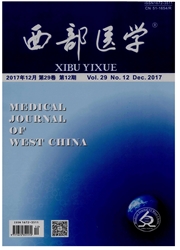

 中文摘要:
中文摘要:
目的探讨骨髓活检(BMB)在不明原因发热(FUO)诊断中的价值。方法收集2012年1月1日至2012年12月31日四川大学华西医院病理科以发热待诊行BMB的患者349例,符合纳入标准者131例。结果31例FUO患者的BMB检查阳性(23.7%),大多数为淋巴造血系统疾病(25/3l,80.6%),余为感染性疾病(6/31,19.4%)。32倒临床病因诊断为血液系统疾病的患者BMB阳性率为78%(25/32),59例临床病因诊断为感染性疾病患者的BMB阳性率仅10.2%(6/59)。除外感染性肉芽肿病变(如结核)和黑热病,多数感染性疾病和免疫系统疾病的BMB病理表现无特异性。单因素分析发现B症状(除发热外)、肝大、脾大、血小板计数降低、白细胞计数降低、中性粒细胞百分比降低、总胆红素升高、碱性磷酸酶升高和LDH升高对BMB具有预示作用。多因素分析发现血小板计数降低具有独立的预示作用。结论BMB是FUO的血液系统疾病病因诊断的有效手段。B症状、肝脾大、血小板计数降低、白细胞计数降低、中性粒细胞百分比降低、总胆红素升高、碱性磷酸酶升高和乳酸脱氢酶升高可作为FUO诊断中BMB的应用指征,而血小板计数降低具有独立的预示价值。
 英文摘要:
英文摘要:
Objective To determine the role of bone marrow biopsy (BMB) in the diagnosis of fever of unknown origin (FUO). Methods We reviewed 349 hospitalized patients diagnosed by fever and took BMB in Department of Pathology, West China Hospital of Sichuan University from January 1 2012 to December 31 2012. We identified 131 patients accepted criteria. Results 31of all the 131 patients (26.7%) were BMB positive. Most of the diagnoses were hematologic disorders (25/31, 80.6%). The others were infectious diseases (6/31,19.40% ). BMB was positive in 25 of 32 patients with clinically diagnosed as hematologic disorders, and the positive rate was 78~ (25/32), and the positive rate of infectious diseases was only 10. 2% (6/59). Besides granulomatous disease (such as tuberculosis) and kala-azar, most of the BMB of infectious diseases and immune system diseases were non-specific. Univariate analysis revealed the following as the positive predictive parameters for taking diagnostic BMB: B symptoms (except fever), hepatomegaly, splenomegaly, thrombocytopenia, leukopenia, decreased of neutrophil percentage, increased of total bilirubin, elevated alkaline phosphatase and increased LDH levels. Multivariate analysis revealed thrombocytopenia was an independent predictive factor. Conclusion BMB is a useful ancillary procedure for making the etiological diagnosis of FUO with hematologic disorders. The following parameters have positive predictive value for take a diagnostic BMB: B symptoms (except fever), hepatomegaly, splenomegaly, thrombocytopenia, leukopenia, decreased of neutrophil percentage, increased of total bilirubin, elevated alkaline phosphatase and increased LDH levels. Thrombocytopenia is an independent predictive factor.
 同期刊论文项目
同期刊论文项目
 同项目期刊论文
同项目期刊论文
 Aggressive natural killer-cell leukemia with jaundice and spontaneous splenic rupture: a case report
Aggressive natural killer-cell leukemia with jaundice and spontaneous splenic rupture: a case report Hepatosplenic T-cell lymphoma: clinicopathologic, immunophenotypic, and molecular characterization o
Hepatosplenic T-cell lymphoma: clinicopathologic, immunophenotypic, and molecular characterization o 期刊信息
期刊信息
